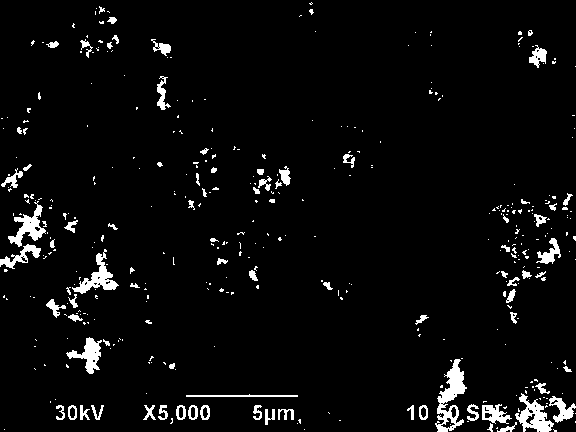Nanometer zinc oxide photocatalyst and preparation method and application thereof
A nano-zinc oxide and photocatalyst technology, applied in the direction of physical/chemical process catalysts, metal/metal oxide/metal hydroxide catalysts, chemical instruments and methods, etc., can solve the problem of high cost and achieve low cost and innovation Strong, fast catalytic effect
- Summary
- Abstract
- Description
- Claims
- Application Information
AI Technical Summary
Problems solved by technology
Method used
Image
Examples
Embodiment 1
[0016] Preparation of nano ZnO particles:
[0017] (1) Preparation of precursors
[0018] Dissolve 0.5065g (3mmol) terephthalic acid in 20mL N,N-dimethylformamide solvent, and slowly add this solution to 1.78g (6mmol) Zn(NO 3 ) 2 ·6H 2 O in 30mL of N,N-dimethylformamide solution, then add 0.85mL of triethylamine, stir for 40min, and filter with suction to obtain a white Zn(II) precursor complex.
[0019] (2) Preparation of nano ZnO particles
[0020] Take 0.2 g of the above-mentioned Zn(II) precursor complex and calcinate at 500° C. for 2 h under a nitrogen atmosphere to prepare nano-zinc oxide photocatalyst.
[0021] figure 1 The scanning electron microscope image of the ZnO nanoparticles prepared for this example is a small particle structure with an average particle size of about 80 nm. image 3 The powder X-ray diffraction spectrum of the ZnO nanoparticles prepared for this example, the diffraction peaks in the spectrum correspond to the diffraction data of ZnO.
Embodiment 2
[0023] Preparation of nano ZnO particles:
[0024] (1) Preparation of precursors
[0025] Dissolve 0.5065g (3mmol) terephthalic acid in 20mL N,N-dimethylformamide solvent, slowly add this solution to the solution containing 0.45g (1.5mmol) Zn(NO 3 ) 2 ·6H 2 O in 30mL of N,N-dimethylformamide solution, then add 0.85mL of triethylamine, stir for 60min, and filter with suction to obtain a white Zn(II) precursor complex.
[0026] (2) Preparation of nano ZnO particles
[0027] Take 0.2 g of the above-mentioned Zn(II) precursor complex and calcinate it at 800° C. for 1 h in an air atmosphere to prepare nano-zinc oxide photocatalyst.
[0028] figure 2 The scanning electron microscope image of the ZnO nanoparticles prepared for this example is a small particle structure with an average particle size of about 80 nm. Figure 4 The powder X-ray diffraction spectrum of the ZnO nanoparticles prepared for this example, the diffraction peaks in the spectrum correspond to the diffracti...
Embodiment 3
[0030] (1) Preparation of precursors
[0031] Dissolve 0.18g (3mmol) formic acid in 20mL N,N-dimethylformamide solvent, slowly add this solution to the solution containing 0.9g (3mmol) Zn(NO 3 ) 2 ·6H 2 O in 30mL of N,N-dimethylformamide solution, then add 0.85mL triethylamine, stir for 120min, and filter with suction to obtain a white Zn(II) precursor complex.
[0032] (2) Preparation of nano ZnO particles
[0033] Take 0.2 g of the above-mentioned Zn(II) precursor complex and calcinate at 400° C. for 1 h in an air atmosphere to prepare nano-zinc oxide photocatalyst.
PUM
 Login to View More
Login to View More Abstract
Description
Claims
Application Information
 Login to View More
Login to View More - R&D
- Intellectual Property
- Life Sciences
- Materials
- Tech Scout
- Unparalleled Data Quality
- Higher Quality Content
- 60% Fewer Hallucinations
Browse by: Latest US Patents, China's latest patents, Technical Efficacy Thesaurus, Application Domain, Technology Topic, Popular Technical Reports.
© 2025 PatSnap. All rights reserved.Legal|Privacy policy|Modern Slavery Act Transparency Statement|Sitemap|About US| Contact US: help@patsnap.com



